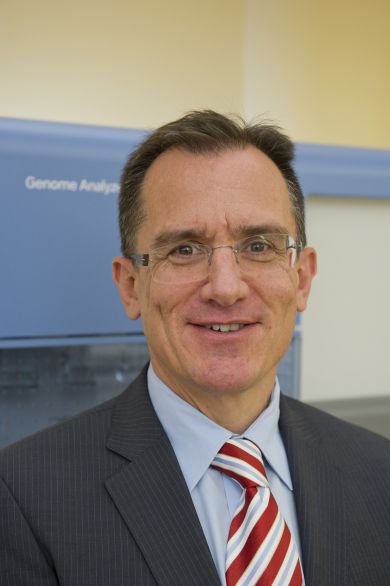Genomic Testing & Precision Medicine: Bigger Is Better
Olivier Elemento, Ph.D., and Mark Rubin, M.D., penned a guest piece in Oncology Times about genomics in oncology and the role of precision medicine. Read the original here.
As we enter a new era of precision medicine, genomic testing is becoming mainstream, yet continues to rapidly evolve driven by clinical needs, availability of new therapies, and technological advances. In parallel with each large-scale genomic study performed, more and more potential candidate genes linked to clinical phenotypes are discovered. Such pressures are inexorably pushing genomic testing toward platforms that can test a wider spectrum of genes.
As a result, whole exome sequencing (WES) is emerging as an attractive platform of choice for a variety of clinical genomic testing applications due its relative affordability and extensive coverage of a rapidly and continuously growing number of clinically relevant genes. As a reminder, WES refers to technologies that effectively capture DNA mapping to coding genes in the genome and only sequence such regions.
In the germline testing arena (sequencing somebody's inherited DNA), WES is used routinely to help provide a molecular diagnostic for diseases with a likely genetic cause. A variety of academic centers and companies offer clinical WES services. Rigorous analyses have shown constitutional (another word for germline) WES provides improved molecular diagnostic capabilities over other technologies. In a relatively restricted number of cases, the genetic diagnosis can inform possible treatments (Cold Spring Harb Mol Case Stud 2015;1,a000265. doi: 10.1101/mcs.a000265). Constitutional WES is frequently reimbursed by medical payers, especially in the pediatrics setting.
Genomics in Oncology
The situation in oncology is a more complex and WES has only recently entered the arena. The premise of precision cancer medicine is that genomic testing can reveal the underlying genomic drivers of individual tumors and thus help match each tumor with one or more therapies that directly target such drivers.
For years, genomic testing of localized tumors frequently has involved using targeted gene panel sequencing. Such panels cover anywhere from 15 to 400 driver genes. Targeted panels covering 50 hot spots within driver genes have long been available in many hospitals and clinics. The advantage for molecular pathology laboratories rests on the ease of testing and relatively restricted challenges with interpreting the results. These panels also have the advantage of requiring very little tissue and DNA; they usually possess a rapid turnaround time (just a few days) and provide deep coverage of each gene thus enabling detection of challenging mutations; this includes mutations in samples with low tumor purity or highly subclonal mutations, that is, mutations present in a small fraction of tumor cells. Popular larger commercial platforms are frequently requested by oncologists. The reports provide significantly more data than hot spot panel tests. The interpretation of the data is facilitated by detailed reports, but still create challenges for the practicing oncologist.
The targeted panel strategy for genomic testing has, in fact, additional limitations. For localized tumors, there are a continuously and rapidly growing number of targeted therapies whose efficacy is tied to the presence of specific genomic alterations within tumor cells. Examples include mutations in the BRAF gene for vemurafenib in metastatic melanoma and HER2 alterations for herceptin in breast cancer. In lung cancer, up to seven genes can be tested as the latest National Comprehensive Cancer Network therapy selection guidelines (EGFR, ALK, BRAF, MET, RET, ROS1, HER2).
Targeted panels may not always cover recently validated driver genes and thus are frequently “behind the curve.” In the setting of advanced metastatic tumors that may have undergone several prior therapies and have developed resistance to chemotherapy, a large variety of pathways may be mutated and mutations frequently occur outside of the traditional driver genes. In fact most of the large-scale genomic studies to date such as from The Cancer Genomic Atlas program only interrogate untreated and mostly localized cancer samples.
Gene Mutations
Equally importantly, there is growing evidence that the strategy consisting of only testing driver genes is clinically suboptimal. Indeed mutations that do not directly drive tumors are often important for treating cancer. For example, deleterious germline and somatic mutations in genes involved in repairing damaged DNA are not only associated with a host of tumors, including aggressive ones (N Engl J Med 2016;375:443-453), but also sensitize tumor cells to certain therapies, such a particular class of therapy (PARP inhibitors) that “push damaged cells over the edge,” essentially forcing such cells to commit cellular suicide.
Likewise, new therapies such as immunotherapies that leverage the immune system to kill cancer cells appear to work better in patients with elevated number of mutations and perhaps even better in patients with neoepitope peptides presented by the MHC complex. Because such neoepitopes are typically not originating from driver genes, genomic testing approaches that only test a small fraction of the exome will miss them. Altogether, this need to interrogate an ever-larger number of driver and non-driver genes within tumors makes whole-exome sequencing a platform of choice. A growing number of institutions including ours (JAMA Oncol 2015;1:466-474; npj Genomic Medicine 2016;1:16019) offer clinically accredited whole-exome sequencing as the primary platform for genomic testing of advanced tumors.
Whole-Genome Sequencing
Perhaps unsurprisingly, limitations of a genomic testing approach based solely on WES are already emerging, calling for the use of further expanded platforms. In the area of germline testing, a growing number of institutions are offering clinical whole-genome sequencing (WGS) services, arguing convincingly that variant calls are more reliable due to less artifacts in WGS than WES, more variants can be interrogated, and turnaround time is faster with WGS compared to WES due to simpler library preparation (no capture step needed).
In oncology, the actionability of a growing number of non-coding mutations such as TERT promoter mutations as well as genomic translocations placing enhancers near genes leading to their aberrant expression, may strongly support use of WGS. Perhaps more importantly, it is increasingly likely that future cancer genomic testing platforms will need to employ a multi-omic approach combining DNA sequencing with a more functional readout of the genome. There are several reasons for this. One is that the expression status of mutated genes matters. Indeed tumors evolve according to a Darwinian process, which means mutations are inherited from ancestor cells. Mutations that used to drive early tumors may not be driving the tumor at the time of testing—perhaps after extensive treatment. Thus systematic analysis of gene expression within tumors—something that can be done using a technique called transcriptome sequencing—including analysis of genes downstream of specific mutations has the potential to reveal (or not) the true driver nature of mutations.
It is also important to remember that the use of expanded and multi-omics platforms abounds with challenges. A significant often cited challenge is the amount of sequence data to store and process—especially for whole-genome sequencing. One hope is that cloud-based storage and cloud analytics may help make this process more affordable in the near future. Another challenge encountered as more mutations are tested is the limited availability of clinical grade annotations to prioritize and describe clinically relevant mutations in clinical genomic reports. Several such databases exist, such as CIViC, PCT, and PMKB, but most of these resources are incomplete and will need constant work to remain up-to-date.
Another perhaps even more challenging problem is the constant lag between availability of expanded platforms for genomic testing and reimbursement by medical payers. Increasing adoption of such genomic platforms perhaps coupled with data sharing efforts such as GENIE, CancerLinQ, and the Precision Medicine Initiative may help demonstrate that expanded platforms do reduce the cost of care and improve outcomes in the long run by identifying the best treatment for each patient and reducing the rate at which treatments with low efficacy are administered to patients.





